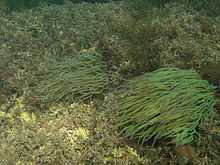Snakelocks anemone
| Snakelocks anemone | |
|---|---|
 | |
| Scientific classification | |
| Kingdom: | Animalia |
| Phylum: | Cnidaria |
| Class: | Anthozoa |
| Order: | Actiniaria |
| Family: | Actiniidae |
| Genus: | Anemonia |
| Species: | A. viridis |
| Binomial name | |
| Anemonia viridis Forskål, 1775 | |
| Synonyms[1] | |
|
Anemonia sulcata | |
The snakelocks anemone (Anemonia viridis) is a sea anemone found in the eastern Atlantic Ocean to the Mediterranean Sea.
The tentacles of anemones in deep or murky water can be a grey colour, but are otherwise usually a deep green colour with purple tips due to the presence of symbiotic algae within the tentacles that use sunlight as an energy source. Since the anemones benefit from this. they prefer brightly lit shallow waters. On average the snakelock anemone is 8 cm wide.
Reproduction
Unlike other cnidarians, anemones (and other Anthozoa) entirely lack the free-swimming medusa stage of the life cycle; the polyp produces eggs and sperm, and the fertilized egg develops into a planula that develops directly into another polyp.
Relationship with other animals
Several species of small animals regularly live in a symbiotic or commensal relationship with the snakelocks anemone, gaining protection from predators by residing among the venomous tentacles. These include the Bucchich's (or anemone) goby (Gobius bucchichi),[2] the shrimp Periclimenes aegylios and the Leach's spider crab (Inachus phalangium).[3]
Human uses
This species is becoming a popular aquarium pet, especially in Europe. It readily adapts to aquaria. This anemone is consumed in Sardinia, orziadas are deep-fried in olive oil also in southwestern Spain, in the Gulf of Cádiz region, as ortiguillas de mar (literally, "little sea nettles", because it has urticant properties before it is cooked), or simply ortiguillas. The whole animal is marinated in vinegar, coated in a tempura-like batter, and deep-fried in olive oil.[4] Ortiguillas are offered in some coastal Andalusian restaurants as a delicacy. They are similar in appearance and texture to croquettes, but have a strong seafood taste.
Gallery
-

A colony in North Devon, UK
-
_1.jpg)
Tentacles
-
In France
-
In France
-

A plate of ortiguillas in Cádiz
References
- ↑ Dr Keith Hiscock 2008. Anemonia viridis. Snakelocks anemone. Marine Life Information Network: Biology and Sensitivity Key Information Sub-programme [on-line]. Plymouth: Marine Biological Association of the United Kingdom. [cited 25/06/2013]. Available from: <http://www.marlin.ac.uk/speciesinformation.php?speciesID=2517>
- ↑ Debelius, H. (1997). Mediterranean and Atlantic Fish Guide. p. 245. ISBN 978-3925919541
- ↑ Debelius, H. (2001). Crustacea Guide of the World. pp. 26 and 89. ISBN 978-3931702748
- ↑ Receta: Ortiguillas de Mar
| Wikimedia Commons has media related to Anemonia_sulcata. |
| Wikimedia Commons has media related to Ortiguillas. |

